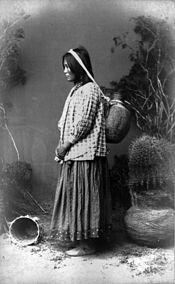
San Carlos Apache woman, c. 1883-1887.
The Western Apache live primarily in east central Arizona, in the United States. Most live within reservations. The Fort Apache, San Carlos, Yavapai-Apache, Tonto Apache, and the Fort McDowell Mohave-Apache Indian reservations are home to the majority of Western Apache and are the bases of their federally recognized tribes. In addition, there are numerous bands. The Western Apache bands call themselves Ndee (Indé) (“The People”); because of dialectical differences the Pinaleño/Pinal and Arivaipa/Aravaipa bands of the San Carlos Apache pronounce the word Innee or Nnēē.
The various dialects of Western Apache (called by them Ndee biyati' / Nnee biyati') are a form of Apachean, a branch of the Southern Athabaskan language family. The Navajo speak a related Apachean language, but the peoples separated several hundred years ago and are considered culturally distinct. Other indigenous peoples who speak Athabaskan are located in Alaska and Canada. Some 20,000 Western Apache still speak their native language, and efforts have been made to preserve it. Bilingual teachers are often employed in the lower elementary grades to expedite that goal, but the tendency toward children learning to speak only English, mingled with occasional Spanish, remains dominant.
The White Mountain Apache are one of several Western Apache tribes, each of which has a different language, history, and culture despite being related. They are related to members of the Yavapai Apache Nation, which also has ties to the Grand Canyon. Historically the White Mountain Apaches were nomadic farmers, growing corn, beans, squash, and other foods for part of the year while supplementing their crops with hunting and gathering of native animals and plants. They had the largest range of any Western Apache tribe and traveled widely throughout what is today east-central Arizona, trading and raiding. As anthropologist Keith Basso pointed out in Wisdom Sits in Places, the land is essential to Western Apache language and culture. It connects the people to their history and ancestors, while serving as a moral compass.
The first significant meeting between the tribe and Euro Americans occurred in 1848 following the Mexican-American war, when Mexico ceded land to the United States that included White Mountain Apache homelands.*
*https://en.wikipedia.org/wiki/San_Carlos_Apache_Indian_Reservation
*https://en.wikipedia.org/wiki/San_Carlos_Apache_Indian_Reservation
CABAN
Kin 97: Red Rhythmic Earth
I organize in order to evolve
Balancing synchronicity
I seal the matrix of navigation
With the rhythmic tone of equality
I am guided by my own power doubled.
Everything that has ever been thought, said or done is registered in the noosphere.*
*Star Traveler's 13 Moon Almanac of Synchronicity, Galactic Research Institute, Law of Time Press, Ashland, Oregon, 2015-2016.
The Sacred Tzolk'in
Manipura Chakra (Limi Plasma)




No comments:
Post a Comment